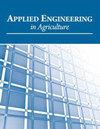The Effects of Crosswind Speed on the Droplet Deposition Distribution of Thrush 510G Aircraft
IF 0.8
4区 农林科学
Q4 AGRICULTURAL ENGINEERING
引用次数: 0
Abstract
HighlightsThe penetration ability of droplet in the crop canopy was in a negative correlation with wind speed.The high wind speed was conducive to the deposition of droplet on the crop canopy in the deposition area.The smaller the wind speed was, the more uniform the distribution of droplets became, and the worse the uniformity of droplet penetration.Abstract. Large plant protection fixed-wing aircrafts are widely used for crop spraying in Northeast China, because their working efficiency matches farm size. However, the spray droplet deposition and drift associated with manned fixed-wing aircraft has not been fully understood in China. The objectives of this study were to quantify effects of the small gradient crosswind speeds of 1.10, 0.83, and 0.58 m/s on the distribution and drift of droplets on soybean in the field. Water-sensitive paper (WSP) was used to collect the droplets on the upper canopy and lower parts of the plant. The results showed that the percentage of droplet deposition (the percentage of droplet deposition on the lower layer to that on the canopy of soybean plant) negatively correlated with the crosswind speeds. The crosswind speed had a significant influence on the deposition of droplets on the canopy and penetration performance. When the crosswind speed was 1.10 m/s, the deposition of droplet on the canopy was maximum and the average value of droplet penetration percentage was minimum, which was 6.11 µL and 50.6%, respectively. The average volume median diameters (VMD or DV0.5s) from all in-swath WSPs of three treatments were all smaller than that of droplet spectrum. The variation coefficients of droplet density in three treatments were 46.8%, 39.6%,and 34.1%, respectively, which indicated that the smaller the wind speed was, the more uniform the distribution of droplets became. The results revealed the influence of crosswind speed on the droplet distribution of large fixed-wing aircraft, which was of great significance to improve the operation. Keywords: Droplets distribution, Penetration, Uniformity performance, Wind speed.侧风速对画眉510G飞机液滴沉积分布的影响
液滴在作物冠层的穿透能力与风速呈负相关。高风速有利于雾滴在沉降区作物冠层上的沉降。风速越小,雾滴分布越均匀,雾滴穿透的均匀性越差。大型植保固定翼飞机因其工作效率与农场规模相匹配,在东北地区广泛应用于作物喷洒。然而,与载人固定翼飞机相关的喷雾液滴沉积和漂移在中国尚未完全了解。本研究的目的是量化1.10、0.83和0.58 m/s小梯度侧风对田间大豆液滴分布和漂移的影响。采用水敏纸(WSP)收集植物冠层上部和下部的水珠。结果表明:雾滴沉降百分率(低层雾滴沉降百分率与冠层雾滴沉降百分率)与侧风速呈负相关;侧风速对水滴的沉积、冠层和穿透性能有显著影响。当侧风风速为1.10 m/s时,雾滴在冠层上的沉积量最大,雾滴渗透率平均值最小,分别为6.11µL和50.6%。3个处理的所有条内WSPs的平均体积中值直径(VMD或DV0.5s)均小于液滴光谱。3个处理的雾滴密度变异系数分别为46.8%、39.6%和34.1%,说明风速越小,雾滴分布越均匀。研究结果揭示了侧风速对大型固定翼飞机雾滴分布的影响,对提高飞机运行效率具有重要意义。关键词:液滴分布,穿透性,均匀性,风速
本文章由计算机程序翻译,如有差异,请以英文原文为准。
求助全文
约1分钟内获得全文
求助全文
来源期刊

Applied Engineering in Agriculture
农林科学-农业工程
CiteScore
1.80
自引率
11.10%
发文量
69
审稿时长
6 months
期刊介绍:
This peer-reviewed journal publishes applications of engineering and technology research that address agricultural, food, and biological systems problems. Submissions must include results of practical experiences, tests, or trials presented in a manner and style that will allow easy adaptation by others; results of reviews or studies of installations or applications with substantially new or significant information not readily available in other refereed publications; or a description of successful methods of techniques of education, outreach, or technology transfer.
 求助内容:
求助内容: 应助结果提醒方式:
应助结果提醒方式:


